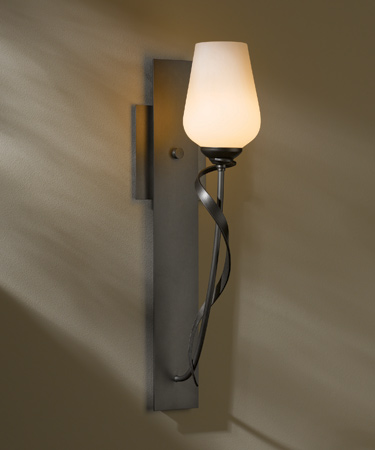
CA. #835032
(925) 595-5049
The picture at top is another good example where task, accent and general lighting are all being utilized in the same room. Notice the recessed can lights in the curved white soffit directly above the curved maple wood desk. This would be a good example of task lighting where the lights are placed directly above the area where work is being performed. Each one of these lights is placed above the opening in the above counter section (where the black brief case is), and is exactly where the person working that section of the counter would be seated. At the far end of the curved white soffit you can see a can light being used to illuminate the clock on the wall, and would qualify as accent lighting. The four recessed can lights in a row at the top left corner are being used as general lighting to light the way to this curved desk. The positions of all these can lights is the result of proper lighting design.
Many different types and styles of lighting fixtures exist today, so many in fact that it can become quite overwhelming to find the one you want to use. Try this list of Various Lighting Manufacturers to see a veritable plethora of different lighting fixtures. Wall sconces are a nice way to add some elegance, along with pendant lights and chandeliers. The options are numerous so take your time and be sure you have chosen the correct fixture.
Elsewhere in this website it is advised that you submit to a contractor along with your plans a Lighting Fixture Schedule. This does not need to be pretty, just informative. It is helpful to a contractor to know as much information about each piece of equipment going into the project. This can also help to keep the cost of your project down as all contractors will be bidding on the exact same fixtures. Many lighting fixtures are an aesthic addition to the home so care must be taken to to get the mounting positions of the fixtures correct. This does take some finesse so please see this Typical Bathroom Vanity Wall illustration to get an idea of the complications of placing lighting fixtures correctly, and yes, this does involve you.
The draiwng at the bottom is of a family room with many recessed can lights. The owner drew this himself. If you are doing a remodel without the help of an architect then you will need to draw something like this so you and your electrician can get on the same page. It does not have to be perfect, or even as good as the drawing shown here, but this kind of thing really helps to alleviate problems with the installation.
On a well drawn lighting plan each fixture will have next to it a designation letter. This designation letter will be listed in the Type column on a
Lighting Fixture Schedule included with the plans. If you click on both these links above you can see how this works. There will be links on the Lighting Fixture Schedule which you can click to see the exact fixture indicated by the designation letters on the plans. This will eliminate most of the common problems we see where the incorrect fixture gets installed, and it also tells the contractor that he will not have to get involved in the decision making process thus saving you, the home owner, some money. This is the way it is done on much larger projects and it works.
Another trait of a well drawn lighting plan is it's architectural dimensions with regard to the proper placement of the lighting fixtures by the electrician. This lighting plan showing dimensions shows some vital dimensions for the placement of the pendant lights over the island, and the placement of the can lights. Having this information on the plans helps the electrician immensely, and should result in a lower installation cost as he did not have to get involved in a discussion about this.
Most states have energy management codes which mandate the use of high efficacy lighting fixtures in and on all residential homes. These codes basically translate to the use of fluorescent or LED fixtures in lieu of the traditional incandescent fixtures. In some cases, like in bedrooms, dining rooms, living rooms, bathrooms etc an incandescent fixture can be used if special provisions are made. These provisions are well known to all experienced electricians. The kitchen is the only room in the house where the use of non high efficacy fixtures is limited to 50% of the total wattage of fixtures installed. Today kitchen lighting is many times fluorescent/LED recessed can lights and perhaps some LED under cabinet lights. The lighting industry has made leaps and bounds in fluorescent technology to the extent that the complaints we all had some decade or so ago with fluorescent lighting are all but non existant.
Good lighting design can make a building look spectacular and envied. Consider your lighting system a vital player in the overall appearance of your home and you will appreciate it later. Proper lighting is just as important as the furnture and art work you have.
Qlr Electric will be happy to assist you in your lighting design and after reading this article you can expect to be able to intelligently talk to your electrician about it.

